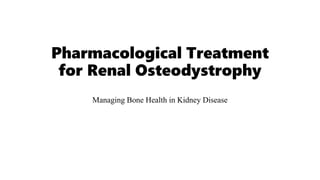Pharmacological Treatment for Renal Osteodystrophy.pptx
- 1. Pharmacological Treatment for Renal Osteodystrophy Managing Bone Health in Kidney Disease
- 2. Key Pharmacological Interventions ? Calcium Supplements: Used to address hypocalcemia and prevent bone loss. Common medications include calcium carbonate. ? Vitamin D Analogues: Regulate calcium absorption and parathyroid hormone (PTH) levels. Examples include calcitriol and paricalcitol. ? Phosphate Binders: Control hyperphosphatemia by binding to
- 3. Additional Pharmacological Interventions ? Calcimimetics: Manage secondary hyperparathyroidism by reducing PTH secretion. Cinacalcet is a common calcimimetic medication. ? Bisphosphonates: Prevent bone loss and fractures in renal osteodystrophy. Medications like alendronate and zoledronic acid are used. ? Monitoring and Adjustments: Stress the importance of


